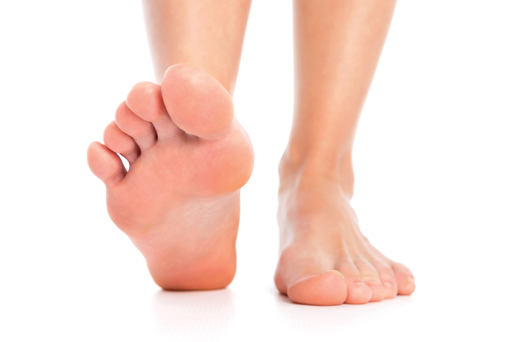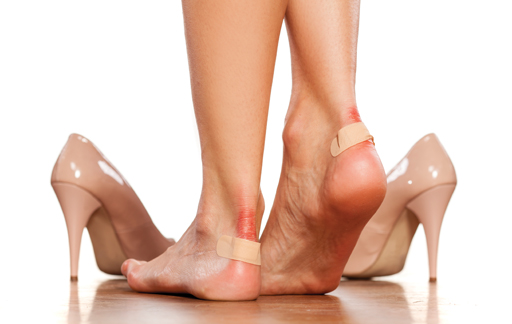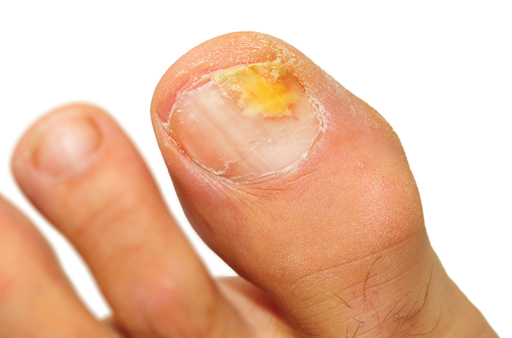Leg & foot care: Best foot forward
In OTC
Follow this topic
Bookmark
Record learning outcomes
Feet are usually shoved in shoes and ignored but, as this month’s Feet for Life campaign points out, paying them a bit of attention can make a big difference.

Learning objectives
After reading this feature you should be able to:
- Recognise common foot problems and how to treat them
- Advise customers how to avoid foot and leg problems
- Know when to refer to a podiatrist.
Â
Despite the high prevalence of various foot ailments, many people are unable to distinguish between a verruca or a corn, for example – which means they may use the wrong products or don’t treat at all. So it is important that pharmacists are able to advise customers on key foot care issues, recommend the correct treatment solution and refer them to a GP or podiatrist if required.
Customer scenarios: Can I treat corns and calluses myself?
Corns and calluses are areas of hard, thickened skin that develop after excessive pressure or friction. If they are causing discomfort or pain, they need to be removed. A podiatrist can do this safely and painlessly, but pharmacy customers may wish to try OTC products initially if they don’t have any underlying health problems, such as diabetes, arthritis or circulatory disorders.
“Customers may be able to soften corns and calluses after a bath with a gentle abrasive and a foot file,†says Mike O’Neill, consultant podiatrist and spokesperson for the College of Podiatry.
“They should avoid using electronic devices as these can take off too much hard skin. Salicylic acid preparations and corn plasters or pads shouldn’t be used by anyone with diabetes. If these products are left on for too long or repeated too often, this may damage the surrounding skin or interfere with the circulation in the feet.
“Customers should use moisturising products for hard skin, especially around their heels, but need to identify the cause of the corn or callus as well, such as wearing tight shoes or too high heels. Customers can try shock-absorbing insoles but, if corns and calluses keep developing, they should seek professional advice.â€
Can shoe inserts help my heel pain?
Most people experience heel pain from time to time, although this can be a sign of a back problem or inflammatory arthritis. Plantar fasciitis, also called ‘heel spurs’, is the commonest type of heel pain and is caused by inflammation to the fascia band (similar to a ligament), which connects the heel bone to the base of the toes. The problem may be triggered by walking, running or standing for long periods. There are no visible signs, but the pain is usually deep and localised in or around the middle of the sole of the heel.
“If someone has typical plantar fasciitis pain on getting out of bed in the morning, this is often due to poor arch structure,†says Mike O’Neill. “Wearing thicker heels and well fitting trainers may help. Many people also benefit from OTC orthotic inserts, which increase shock absorption and improve control of the foot, but these really need to be used as part of an overall stretching programme rather than on their own. Pharmacists can signpost customers to appropriate websites, such as that of the College of Podiatry.â€
What is causing my cracked heels?
Most hard, thick skin feels like parchment and will crack over time unless it is treated. Cracked heels, or heel fissures, are splits in the skin around the heel. “When pressure is put onto the heel from our bodyweight while walking and standing, the skin needs to stretch and spread out a little,†says Superdrug clinical development manager, Niamh McMillan. “If the heel can’t stretch because the skin is dry and inflexible, it will split.â€
Mike O’Neill recommends using a foot file and rich moisturiser to prevent and treat cracked heels. “Customers should try products containing lactic and/or uric acid, as these moisturise the skin and exfoliate at the same time,†he says. “They may notice cracked heels if they regularly wear flip flops or shoes with an unstructured back.â€
How can I deal with blisters?
Most blisters develop from new footwear or wearing one pair of shoes too regularly. They are more likely to occur in hot weather, especially in women who don’t wear socks in ballet pumps.
“The feet are held in pumps by pressure from the heels and toes, which then become irritated and inflamed, leading to a blister,†says Mike O’Neill. “Wearing socklets may help. Some people get blisters from summer footwear, as the leather dries out over time. It is important to moisturise the leather, so shoes and sandals are less likely to rub.â€
If blisters develop, they should be left to heal naturally but customers can protect them from bursting with specialist blister plasters. “Most blisters do heal by themselves within a week but they can often burst,†says Jackie Hall, health at hand operations manager at AXA PPP healthcare.
“It is important to avoid bursting the blister, because this could lead to an infection or slow down the healing process. If this happens, try to keep the skin intact to protect the wound underneath. When a blister does burst, don’t peel off the dead skin. Instead, allow the fluid inside the blister to drain and cover the area with a dry, sterile dressing to protect it from infection until it heals.â€

How can I prevent ingrowing toenails?
Ingrowing toenails are most likely to affect the big toe. The edges or corners of the nail grow into the surrounding skin, causing pain, swelling, redness and sometimes an infection.
“Customers can use antiseptic in the nail corner and keep their feet open to the air, rather than covered with a restrictive dressing,†says Mike O’Neill. “If customers keep getting ingrowing toenails, they may need a small amount of nail taken away after the inflammation settles down. Pharmacists will often see people taking antibiotics for ingrowing toenails, but if customers need these more than twice, they should be signposted to a podiatrist for a wedge resection.â€
Why does my athlete’s foot keep coming back?
Athlete’s foot usually occurs between the toes or the bottom of the feet. If it isn’t treated immediately, it can spread to other parts of the body or to other people. Antifungal treatments are available as creams, sprays, liquids and powders, which should be applied not just to the affected skin, but also to the surrounding area(s).
All treatments should be continued after the rash has cleared up to make sure all the fungus has gone. Customers should be reminded to wash their hands thoroughly after using the treatments, as the athlete’s foot fungus spreads easily.
“Reinfection is common in people who play a lot of sports,†says Mike O’Neill, “as they often leave trainers in their gym bag, providing a dark and damp place for the fungal spores to grow in. They should wear flip flops in changing rooms and dry their feet properly after swimming, then use a foot spray on their feet and inside their shoes before putting their shoes back on.â€
Why does my toenail look yellow?
Some toenails are naturally yellow or may be easily stained by nail polish. However, if a nail remains yellow for no reason, it is likely to be a fungal nail infection (onychomycosis). “This usually starts at the rim of the nail, which will eventually turn whitish-yellow,†says Neil Murphy, commercial director of VeMedia.
“The fungus then grows into the nail, causing the nail plate to thicken, become brittle and may separate from the nail bed, which can be extremely painful. Nail fungus is problematic because it resides inside the nail and if not treated properly can result in the complete loss of the nail.â€
Mike O’Neill recommends customers try OTC fungal nail products, by filing the nail down and applying the treatment once or twice a week, alongside athlete’s foot treatments. However, if the infection is extensive, with more than three nails affected, customers should visit a podiatrist.

What is causing my smelly feet and how can I stop this?
Food odour is common during puberty when hormone levels fluctuate, and also in people who tend to wear the same shoes every day. “Smelly feet is an issue associated with the bacteria that naturally live on our skin,†says Dan Bracey, in-house sweat expert at Odaban. “In confined areas such as shoes, these odour-producing bacteria are able to flourish. The simplest and most effective way to deal with such issues is to tackle the warm and damp environment that these organisms require to multiply.â€
To prevent foot odour from building up, Mike O’Neill recommends letting shoes dry out in the sunshine, if possible, between uses and washing trainers in warm soapy water (not in a washing machine). Customers can use a deodorising foot spray to prevent mild odour, but may need a more specialised anti-perspirant foot spray or powder.
How can I recognise a verruca and should I treat it?
Verrucas are a type of wart that affects the bottom of the feet and present as small lumps on the skin. “They usually develop on the soles and are white but can appear with a black dot in the centre,†says Niamh McMillan. “They tend to be flat and can be painful.â€
Mike O’Neill says verrucas should be treated if they are painful or appear between the toes. “Try salicylic acid products first, especially in children,†he says. “I’m not keen on cryosurgery or freezing sprays, as these can cause the verruca to spread if not used properly. It can take two to three months of treatment for the verruca to disappear completely. If OTC products aren’t working, customers should be advised to go to their podiatrist, rather than treat themselves for too long.â€

Why am I prone to varicose veins?
Varicose veins occur when valves in the leg veins stop working properly, resulting in blood flowing down the veins the wrong way. Varicose veins affect 30 per cent of adults, according to Professor Mark Whiteley, vascular expert at the Whiteley Clinic. “There is a stereotype that it is only the old and the overweight that will suffer from them,†he says, “but the condition is hereditary and can strike at any time of life – although it does become commoner with passing years.â€
Although varicose veins are thought to be bulging veins that protrude from the legs, in up to half of all cases the problematic veins remain hidden under the skin. “Many people will often seek simple removal of these thread or spider veins,†says Professor Whiteley. “However, if the underlying hidden varicose veins have not been found and treated first, then thread or spider vein treatments are much less likely to work.â€
Why are my legs aching?
Tired, aching legs are a common problem, especially in people who sit or stand for long periods. It could be a sign that leg veins are allowing blood to flow backwards and pool, rather than travel up towards the heart. Insole arch supports may provide extra support for the ankles, which can limit any swelling, while compression hosiery can improve the flow of blood, relieving the tiredness and aching sensation.
I’ve a painful leg – could it be deep vein thrombosis?
Deep vein thrombosis (DVT) causes pain and swelling in the leg as a result of blood clotting while it is still inside the blood vessel. It usually affects one leg only. If DVT symptoms occur, they may include tenderness in one leg (usually the calf), a heavy ache in the affected area, warm skin in the area of the clot, and also red skin, particularly at the back of the leg below the knee. If customers are concerned about DVT, they should see their GP.
For the latest product news in the leg & foot care category, click here.
Â
Feet for life
June is Feet for Life month, organised by the College of Podiatry to highlight the importance of foot care. This year’s campaign highlights the key foot health issues to be aware of at all life stages, with the focus on three areas:
• Babies and children: The campaign covers the importance of well-fitting and appropriate socks and shoes to ensure that growing feet are kept healthy and gives advice on how to choose appropriate footwear for young children. It also provides information about key foot health issues affecting children and teenagers, such as athlete’s foot and sweaty feet
• 18-40 age group: The focus is on everyday footwear, including how to find the perfect heel height, choosing summer shoes and tips to find the right sports shoe. It also includes information on common foot ailments Â
• Over 55 age group: This part of the campaign looks at foot problems that are commoner as people age, including those linked to diabetes, arthritis and general circulatory problems. It also gives advice on general foot care and choosing appropriate footwear.
